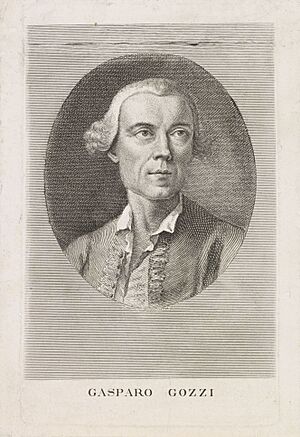Gasparo Gozzi facts for kids
Gasparo Gozzi (born December 4, 1713 – died December 26, 1786) was an important writer from Venice, Italy. He was known for being a critic (someone who judges and writes about art or literature) and a dramatist (someone who writes plays).
Quick facts for kids
Gasparo Gozzi
|
|
|---|---|

Portrait of Gozzi by Francesco Bartolozzi
|
|
| Born | December 4, 1713 |
| Died | December 26, 1786 (aged 73) Padua, Italy
|
| Nationality | Italian |
| Occupation | Critic, dramatist |
| Spouse(s) | Luisa Bergalli (m. 1739) |
| Children | 5 |
| Family | Carlo Gozzi (brother) |
Contents
Gasparo Gozzi's Life Story
Gasparo Gozzi was the oldest of eleven children. His parents, Jacopo Antonio and Angela Tiepolo, were both from noble families in Venice. His younger brother, Carlo Gozzi, also became a famous writer.
Gasparo studied at home with tutors when he was young. Later, he went to the College of Murano. There, he learned many subjects like history, philosophy, and languages. He also studied mathematics and law, but he was most interested in literature and writing.
In 1739, Gasparo married a poet named Luisa Bergalli. They had five children together. In 1747, they tried to run a theatre in Venice called Sant'Angelo. Gasparo wrote plays for the actors, mostly by translating French plays. They hoped this would help their money problems, but the theatre lost money. They had to close it the next year, but Gasparo kept writing plays.
His Famous Writings
Gozzi became known for writing serious and thoughtful works. One of his most famous works was a series of 14 prose pieces called Dialoghi dell’isola di Circe (Dialogues from Circe's Island). These were published between 1760 and 1764.
The idea for these dialogues came from an older work by Giovan Battista Gelli. In Gozzi's version, Ulysses gets permission from the sorceress Circe to talk to men on her island. These men have been turned into animals.
The stories show how society works. Many of the "victims" actually prefer being animals! The only one who wants to be human again is a bear. This bear was a satirist (someone who uses humor to criticize society) who had dared to criticize Circe. Gozzi used this bear to represent himself, as a noble critic of human behavior.
Journalism and Public Service
In 1760, Gozzi started a newspaper called Gazzetta Veneta. He wanted it to be like a popular English newspaper called The Spectator. He later started another one called L'Osservatore Veneto.
Even though these newspapers were not very successful, Gozzi became known as one of Italy's best critics and most elegant writers. From 1762, he started getting important public jobs. First, he worked for the University of Padua, and then for the Republic of Venice.
In these roles, he wrote reports about printing in Venice. He looked at the history of publishing in Venice and suggested ways to improve it. For a long time, he was also the censor of the press in Venice. This meant he checked books and newspapers before they were published.
In 1774, he was asked to reorganize the university system in Padua. He stayed there until he passed away. Gasparo Gozzi is buried at the San Michele cemetery on the Isola di San Michele, along with his brother Carlo Gozzi.
What Did Gasparo Gozzi Write?
Here are some of Gasparo Gozzi's main writings:
- Lettere famigliari (1755): This was a collection of short, lively pieces in prose and poetry. They covered many interesting topics.
- Sermoni: These were poems written in blank verse, similar to the style of the ancient Roman poet Horace. The first 12 were published in 1763, and six more were added after he died.
- Giudizio degli antichi poeti sopra la moderna censura di Dante (1755): In this work, Gozzi defended the great poet Dante Alighieri against attacks from another writer named Saverio Bettinelli.
He also translated many works from French and English. These included Tales by Jean-François Marmontel and Essay on Criticism by Alexander Pope. All of his collected works were published in Venice between 1794 and 1798, in 12 volumes. Many new editions have been printed since then.

